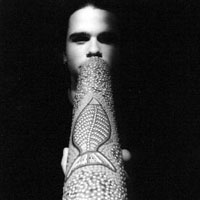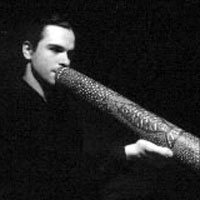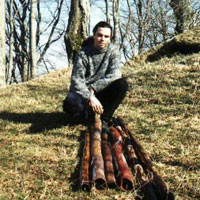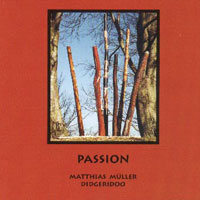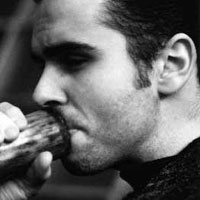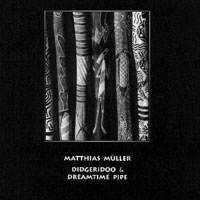Matthias Müller - Didgeridoo
The didgeridoo, which is the Australian Aborigines' wind and rhythm instrument, is one of the world's oldest musical instruments. It is crafted from a eucalyptus bough which had been hollowed out by termites, and its surface often features artistic designs. In contrast, the dreamtime-pipe originates from Arizona in the United States; it is made from the stalk of an agave. The playing technique is identical for both instruments. The vibrating keynote defines the didgeridoo's and the dreamtime-pipe's basic timbre. The circular breathing technique, which affords the instrument its permanent sound, creates multitudinous and exciting sound patterns by conflating its keynote, its overtone and rhythm. By virtue of this special breathing technique, and by the further means of specific ways of blowing, larynx and voice variations, a fabulous diversity of expressive modes arises. These simple monotonic instruments demand as much work and discipline from their player as the serious occupation with classical music or jazz. From the listener, too, a different mode of attention than our Western habits is demanded. But if one disengages from one's local habits of listening, one discovers a fascinating and unique world of sound. Although rhythm predominates, the sound patterns range from the instrument's gentle and whispering breath to piercing cries. Given this musical variability, the instrument can communicate emotional sensuousness as well as ecstatic rhythms with enormous expressiveness. From archaic ur-sounds to stratospheric tunes full of feeling, everything is possible. Matthias Müller is among the best-known virtuosos playing these two instruments in Europe. This is not only witnessed by his public performances, but also by various appearances on radio and television. It is fascinating to listen to the masterly, singularly innovative creations of sound and rhythm he can elicit from these ancient wind instruments. Before becoming an enthusiast of the didgeridoo, he was engaged in experimental sound creation, adapting everyday objects to his musical purposes. He does not just focus on Australian models or an imagined world of Australian Aborigines, his interests therefore go beyond that particular universe of sound.
He has always been inspired by the tones and sounds that surround him and he expresses his physical and mental perceptions through their musical transformation. At the same time, he is interested in sounds that are produced by comparable instruments in totally different cultures. Such a relationship exists for instance between the didgeridoo and the alpenhorn, an instrument which Matthias Müller has intensively studied since 1997. But his musical and theatrical interests go even beyond that. He is increasingly looking for contacts with other styles of music and other branches of art – be it in mixing Aboriginal musical traditions with established Western music, jazz, funk and house or in collaboration with pictorial artists, as well as by including video art. Today he already has succeeded in combining the didgeridoo with the typically Swiss alpenhorn, thus creating an extraordinary musical fusion of two cultures. His performances also offer striking visual experiences, since he also tries to explore the physical dimension of his music. During a concert, he often moves lithely through the auditorium with the lighter dreamtime-pipe, filling the room with sounds from all directions. On these occasions audiences realise that they are witnessing a musical professional who challenges his abilities to the utmost.
